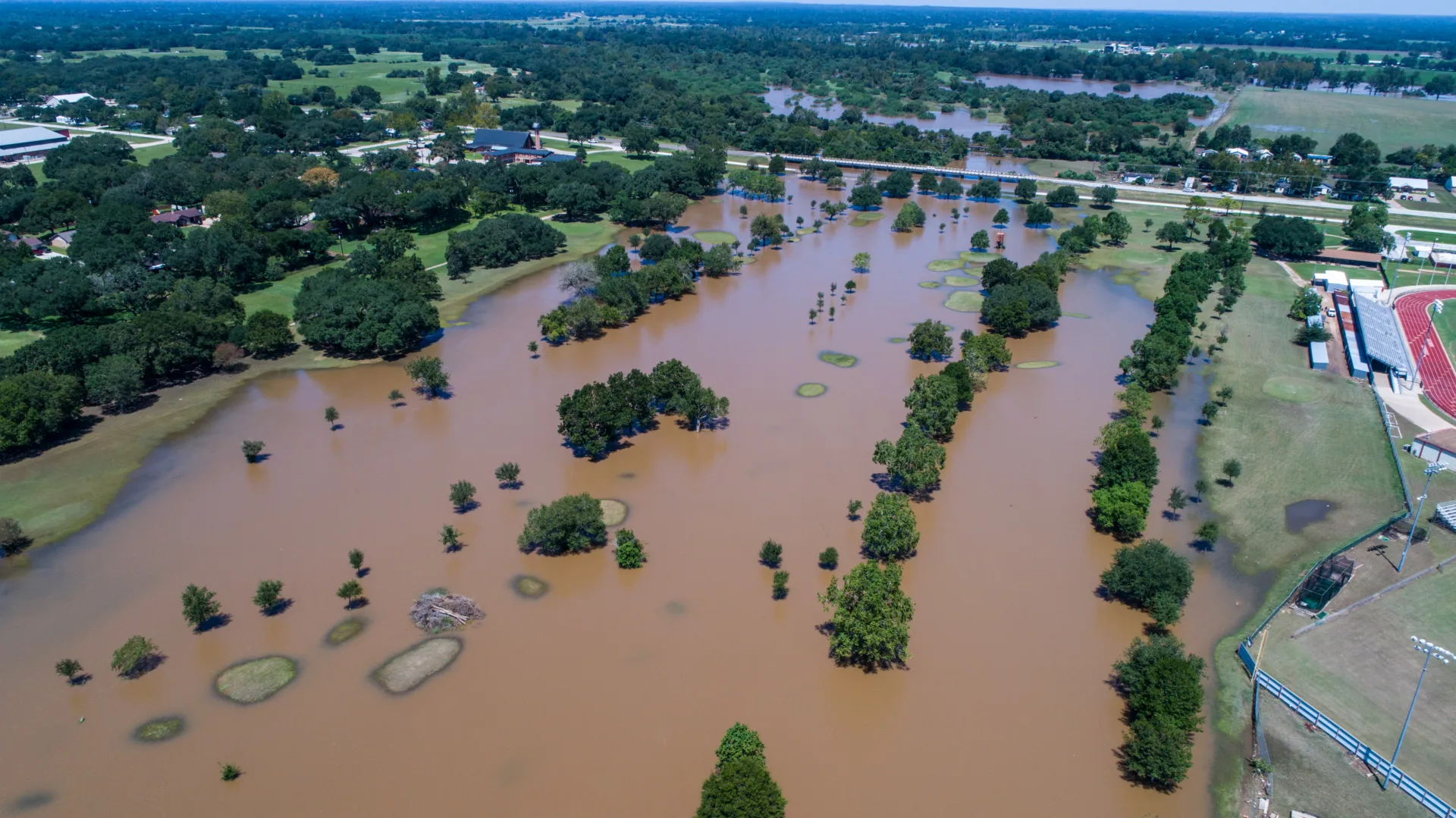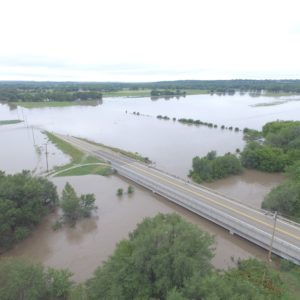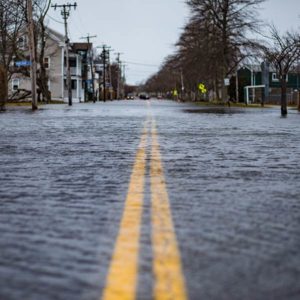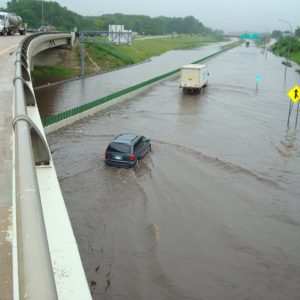Smaller, rural, and lower-income communities struggle to access federal funding for hazard mitigation and climate change adaptation. These communities often lack personnel and expertise to write competitive grant proposals, and federal proposal-scoring criteria put them at a disadvantage.
Why we wrote this:
Barriers to accessing federal funding – including requirements such as conducting a benefit-cost analysis – can prevent rural and low-income communities from building critical infrastructure and resilience projects. New models and BCA alternatives show that it is possible to quantify the benefits of reducing climate risks for all people.
The benefit-cost analysis (BCA) that is used by FEMA and other federal agencies to prioritize funding for flood mitigation and recovery can be a barrier to rural communities. While the BCA is not the only factor considered in deciding which projects to fund, maximizing net benefits is an important criterion in federal grantmaking.
Benefit-cost analyses are designed to ensure that projects are cost effective. In practice, however, they can undervalue the benefits of mitigation projects in lower-capacity and lower-income communities. This can result in the inequitable distribution of federal mitigation funds and perpetuate legacies of disinvestment in rural, under-resourced communities.
A BCA often requires highly technical information that is beyond the capacity of many smaller communities to generate. But even when a BCA is completed, the information handicaps rural and under-resourced communities in three ways:
- Benefits and costs are defined too narrowly.
- BCA prioritizes property values over people.
- BCA contributes to inequitable outcomes.
Both the implementation and use of BCAs need revision to promote climate resilience in a broader set of communities. Innovative alternatives already in use by some local governments can serve as models.
1. Benefits and costs are defined too narrowly.
FEMA is mandated by the Robert T. Stafford Disaster Relief Emergency Assistance Act to invest in mitigation projects that are cost effective, a criterion that is fulfilled through the use of a benefit-cost analysis. In theory, the BCA ensures that the public receives its fair share of benefits from tax-funded government investments.
However, how the BCA is operationalized – including which benefits and costs are included and how they are quantified – has an outsized impact on which mitigation projects receive federal funding from FEMA. (Read more about benefit-cost calculations below.)
Federal agencies tend to have narrow definitions of benefits and costs. Benefits are measured by the future costs or losses avoided (in terms of dollars) by implementing the project. Notably, only benefits that can be monetized can be included in the BCA.
Only benefits that can be monetized can be included in the BCA, excluding many social and cultural values.
Subscribe to our newsletter!
The narrow scope of allowable benefits and costs are evident in FEMA’s criteria. Social and environmental benefits, such as avoiding lost worker wages or restored watersheds, can only be included as supplementary to avoided losses such as damage to buildings, belongings, and infrastructure, and loss of services and functions.
Costs from a reduced tax base, indirect economic losses, and insurance premiums can not be included in a FEMA BCA because FEMA’s definition of “mitigation project costs” is limited primarily to construction costs, project-related costs (such as title searches and permits), and maintenance costs.
Conducting a comprehensive BCA that accounts for all allowable benefits typically requires expertise in hazard modeling, GIS, and engineering. Rural and low-income communities may not be in a position to conduct BCAs with a full accounting of all, or even most, allowable benefits.
2. Benefit-cost analysis prioritizes property values over people
The benefit-cost analysis is based on the amount of property value protected, as opposed to the number of homes or people affected. Projects built in places with higher value properties often have a higher benefit-cost ratio than projects built in communities or neighborhoods with lower property values. The BCA can thus make it harder for lower-income and disadvantaged communities to qualify for federal funding.
BCA is based on the value of property protected, as opposed to the number of people impacted.
Community Lesson: Richwood, West Virginia
A low benefit-cost ratio contributed to Richwood, West Virginia’s failure to secure mitigation funding. Richwood is a small community of 2,100 people with high levels of poverty – more than 30% of its residents live below the poverty level. Richwood has significant flood risk. According to data from First Street Foundation, 43% of the city’s properties have severe flood risk.
Over the last 50 years, the city has tried to fund mitigation projects through the Army Corps of Engineers, the U.S. Department of Agriculture, and FEMA programs. However, the benefit-cost ratio was not high enough to secure funding in any of these applications because of the community’s low property values.
With no solution in place, the community experienced devastating flooding in 2016 when nine inches of rain fell within 24 hours. Eighty homes were damaged, 100 homes were destroyed, and broader economic losses rippled through the community – including the closure of a nursing home and the local grocery store.
The BCA’s over-emphasis on property values created a barrier for Richwood to access critical federal funding for mitigation, putting its most vulnerable residents at risk.
3. Benefit-cost analysis contributes to inequitable outcomes
The benefit-cost analysis tallies benefits and costs at the project level, but the distribution of costs and benefits accrue to individuals differently – and often unequally.
For example, research clearly demonstrates that disasters impact people differently based on race and socioeconomic status. People with less wealth are more exposed to short- and long-term costs associated with disasters. However, the BCA – as it is currently calculated – does not account for these differences.
The BCA also shapes the types of mitigation projects that communities can qualify for and implement. Generally, wealthier communities secure funding for projects that help them stay in place, such as building expensive sea walls or levees, while less wealthy communities secure funding for buy-outs and solutions that result in displacement. This creates a disaster mitigation strategy that allows wealthy communities to strengthen while poorer communities are disrupted and often broken apart.
Wealthier communities generally get funding to stay in place, while less wealthy communities are often displaced, disrupted, and fractured.
The BCA also shapes who receives federal funding. In the inaugural funding round for FEMA’s Building Resilient Infrastructure and Communities (BRIC) grant, 94% of the funding went to wealthy coastal states. The largest grant – $50 million – will be used to build a six-mile, 16-foot tall levee as part of the SAFER Bay Project in Menlo Park, California. The project’s BCA benefitted from the community’s high-value commercial properties, including Facebook’s $2.5 billion Menlo Park campus. In contrast, communities throughout the Intermountain West, Midwest, and Gulf Coast states – many of whom were reeling from record-setting flooding and wildfire events – failed to secure any competitive grant funding in BRIC’s first year of funding.
Community Lesson: Cedar Rapids, Iowa
Cedar Rapids has been successful in implementing flood risk reduction measures, however BCAs have resulted in stark disparities across higher- versus lower-income neighborhoods.
Cedar Rapids is a community of 132,000 residents that flanks the Cedar River. After experiencing a historic flood in 2008, the city launched a massive $750 million plan for 30 flood control projects. However, piecing together funding has been challenging because of BCA requirements. The US Army Corps of Engineers evaluated projects on both the east and west sides of the Cedar River. Funding was approved for the east side of the river, where the neighborhood has high-property values and a Quaker Oats Plant is located. Funding was not approved for the lower-income neighborhood on the west side of the river.
Benefit-cost analyses can be revised for more equitable outcomes
The benefit-cost analysis is increasingly seen as needing reform. In 2021, the Urban Institute released a report calling for broader project selection criteria and more community engagement to prioritize equity in federal funding decisions.
Innovative alternatives to BCAs in use by some local governments are yielding more equitable mitigation and can serve as models.
Community Lesson: Charlotte-Mecklenburg County, North Carolina
In Charlotte-Mecklenburg County, North Carolina, the county’s flood buy-out program previously relied on federal grants to fund most of its projects. However, using the BCA to secure federal funding did not result in projects that benefitted the entire community. One county official pointed out the clear inequity in federal flood buyout programs: people who didn’t own property got nothing out of the program.
In 2012, the county developed a local risk-assessment tool based on factors beyond property values and avoided damages. The assessment assigned points to factors such as whether or not flooding was reaching parked cars, whether there would be emergency access in a flood event, and what level the water ultimately reached in a house. Using points instead of dollars enabled officials to follow a more holistic approach to project prioritization and funding, as well as a better buyout justification for property owners. In 2021, Charlotte-Mecklenburg County rolled out a new version of the tool and published a community guidebook to help other communities follow in its footsteps.
As a tool for assessing efficient resource allocation, the BCA is a cornerstone for the federal government’s justification of the use of public money. It attempts to promote efficient resource allocation through well-informed decision-making while ensuring that programs are more likely to result in economically viable solutions. Additionally, the BCA can add a layer of objectivity through numeric analysis, with numbers providing an intuitive, less contentious foundation. Many government agencies are required by law to incorporate a BCA into their evaluation of grant applications.
However, BCA has resulted in a strategy based on the idea of adaptation for capital rather than people. A BCA is unable to adequately account for nonfinancial risks and impacts such as those relating to social and cultural issues. Inherent in the BCA’s economic foundation is the monetization of benefits and costs, which leads to the exclusion of impacts that are not easily quantified.
Recommendations
Federal agencies should consider the following solutions to help rural communities overcome the barriers to accessing funding posed by Benefit Cost Analyses:
Fund community assistance: Technical assistance programs can support rural and low-income communities as they navigate BCAs and other complicated grant requirements. Workbooks and guidance documents are insufficient. Programs that provide tailored assistance, such as Headwaters Economics’ Community Planning Assistance for Wildfire and FloodWise Communities programs, are more helpful for building local capacity.
Make BCAs more flexible: BCA criteria can be revised and broadened beyond property values to accommodate social and environmental benefits. New models, such as the approach in use in Charlotte-Mecklenburg County, show that it is possible to quantify and prioritize the benefits of reducing climate risks for all people.
Prioritize equity: Proposal criteria can be modified for communities that are currently failing to compete for federal funding. The BCA requirement can be deemphasized or even eliminated for rural and low-income communities.
FEMA and other federal agencies are currently using the BCA to allocate resilience funding in a way that undermines climate equity goals. The implementation and use of BCAs need revision to promote resilience in a broader set of communities.
How do you calculate a benefit-cost ratio?
The benefit-cost analysis results in a benefit-cost ratio that demonstrates cost effectiveness. A benefit-cost ratio is calculated by dividing the total amount of benefits (expressed in dollars) by the total costs for the mitigation project. When the ratio is more than 1.0, the project is said to be cost effective. When the ratio is less than 1.0, the project is not cost effective and will not qualify for most FEMA mitigation funding.
FEMA has simplified many of the benefits and costs by offering standard values for common components such as in its FEMA BCA toolkit. For example, in 2021 the pre-calculated benefit for elevating a home in the Special Flood Hazard Area is $205,000 per structure. Both benefits and costs are annualized in the calculation by considering hazard frequency, damage data, project effectiveness, and the project’s useful life.
While the concept behind a benefit-cost ratio is easy to understand, its actual computation through a benefit-cost analysis is often highly technical. Most BCAs require a range of expertise, including engineering, GIS, and economic analysis. The technical aspects of BCAs create a barrier that makes it harder for disadvantaged and lower-income communities to access federal funding.

GUEST CONTRIBUTOR
Emily Pape
Emily was a research fellow with Headwaters Economics in the summer of 2021 while studying at the University of Chicago’s Harris School of Public Policy.







